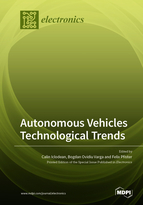Autonomous Vehicles Technological Trends
A special issue of Electronics (ISSN 2079-9292). This special issue belongs to the section "Electrical and Autonomous Vehicles".
Deadline for manuscript submissions: closed (31 December 2022) | Viewed by 37941
Special Issue Editors
Interests: electric vehicles; fuel cell vehicles; powertrain concept; electronic control unit; in-vehicle communication network; energy efficiency; autonomous vehicles; computer modeling and simulation in the automotive field
Special Issues, Collections and Topics in MDPI journals
Interests: electric vehicles; hybrid vehicles; electric vehicle battery, fuel cell vehicles; autonomous vehicles; general powertrain efficiency; OBD diagnostics protocols; powertrain simulation; virtual vehicle testing
Special Issues, Collections and Topics in MDPI journals
Interests: vehicle simulation platforms; ADAS; HIL; ECU control and simulation; vehicle dynamics; virtual vehicle testing
Special Issues, Collections and Topics in MDPI journals
Special Issue Information
Dear Colleagues,
The automotive industry has always gone hand in hand with research and innovation, but nowadays the industry is adding pressure and is establishing the agenda of the researchers from the field. The vision is launched; the hardware and the software exist; the only question remaining is: “who is going to deliver”? To answer this question, we provoke scientists, researchers, and industry specialists together with academics to share their vision of the autonomous vehicle. What will the platform look like, what kind of hardware and software is most suitable, who will make the link and the connection between these two interdependent environments (and how) so that in the end the AI will define the process: all these are the hot themes of the moment and this Special Issue will help all those interested in the topic to promote their vision and ideas. Since the automotive field does not belong to a classic scientific field but has become an independent self-made scientific branch, all those who feel that they can bring their contribution to this highly dynamic environment are requested to join in promoting their particular research or reviews in this Special Issue coordinated from both academia and the industry.
Dr. Calin Iclodean
Prof. Dr. Bogdan Ovidiu Varga
Dr. Felix Pfister
Guest Editors
Manuscript Submission Information
Manuscripts should be submitted online at www.mdpi.com by registering and logging in to this website. Once you are registered, click here to go to the submission form. Manuscripts can be submitted until the deadline. All submissions that pass pre-check are peer-reviewed. Accepted papers will be published continuously in the journal (as soon as accepted) and will be listed together on the special issue website. Research articles, review articles as well as short communications are invited. For planned papers, a title and short abstract (about 100 words) can be sent to the Editorial Office for announcement on this website.
Submitted manuscripts should not have been published previously, nor be under consideration for publication elsewhere (except conference proceedings papers). All manuscripts are thoroughly refereed through a single-blind peer-review process. A guide for authors and other relevant information for submission of manuscripts is available on the Instructions for Authors page. Electronics is an international peer-reviewed open access semimonthly journal published by MDPI.
Please visit the Instructions for Authors page before submitting a manuscript. The Article Processing Charge (APC) for publication in this open access journal is 2400 CHF (Swiss Francs). Submitted papers should be well formatted and use good English. Authors may use MDPI's English editing service prior to publication or during author revisions.
Keywords
- autonomous vehicle (AV)
- autonomous driving systems (ADS)
- advanced vehicle control
- driver assistance systems
- automotive computing platform
- adaptive AUTOSAR for ADS
- autonomous vehicular clouds and edges
- internet of vehicles (IoV)
- advanced vehicular networks
- neural networks for ADS
- V2X communications
- big data for connected vehicles
- human-vehicle interface
- cyber security in autonomous driving
- 5G/6G applications in autonomous driving
- smart sensors for AV
- multi-sensor data fusion
- multi-sensor data processing
- AV perception
- target perception and recognition








